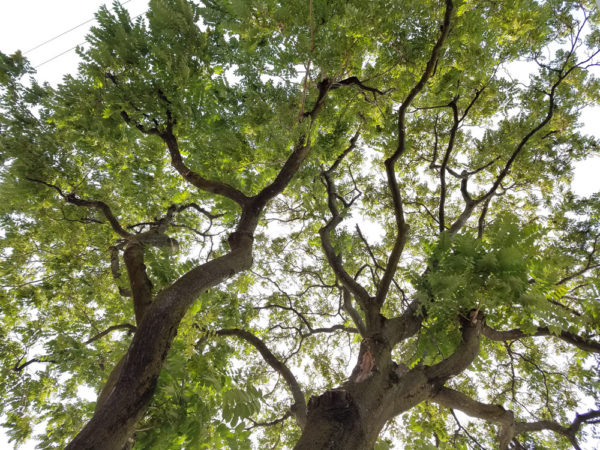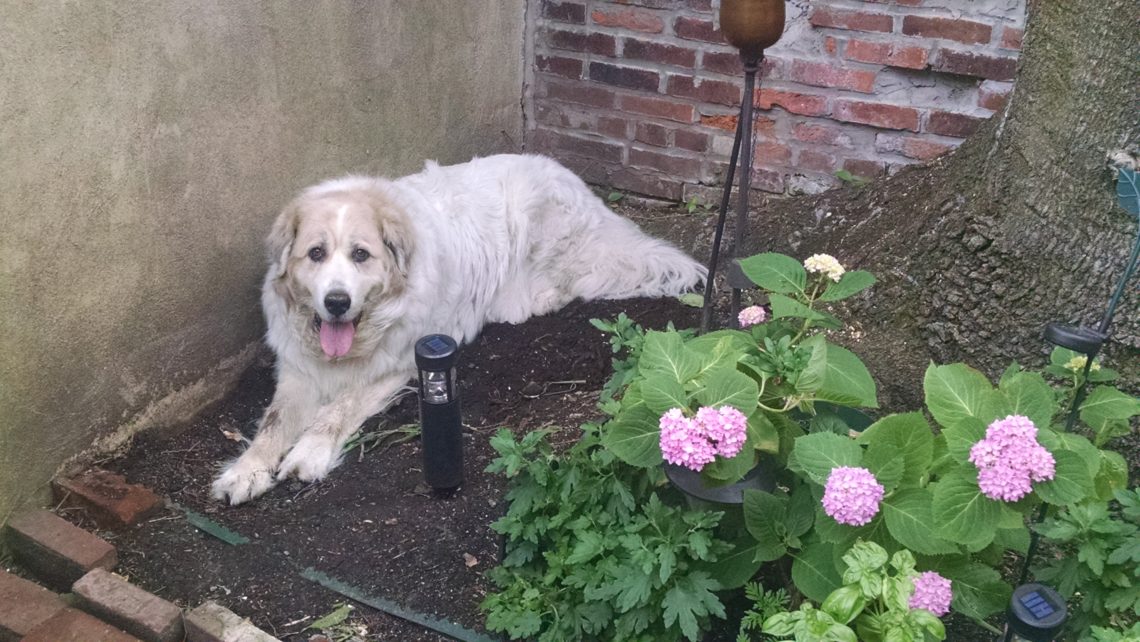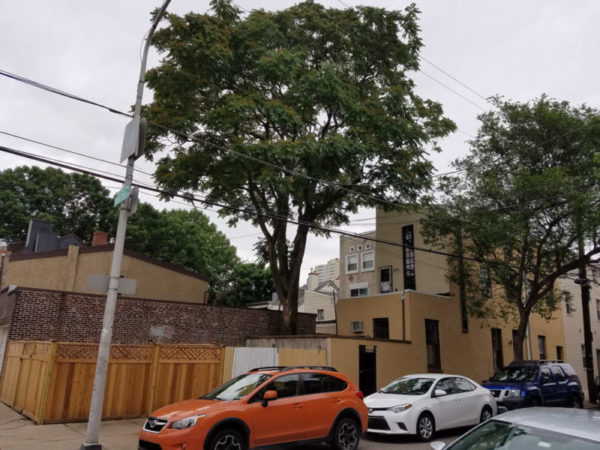4 Month old sister kittens, Bubbles and Heart, watching the birds in the Big Old 2St Tree. They are rescues from a neighbor in Queens Village. They love sitting in the stairs and looking out the window at the birds in the tree.
Articles by Editor
Sounds from the Tree
capturing life and Sounds under the Big Tree.
Listening to the wind rustling the leaves and the local birds chirping away.
A Big Old Dog and A Big Old Tree
Cookie our 135 lb Great Pyrenees Rescue dog Loves her Big Tree.

Ever since we adopted Cookie 5 years ago, she has loved the Big Tree. Mom and her have finally divided up their shares of the tree floor. I truly think she will miss the tree, if we lose it.
She loves the natural cooling a big shade tree provides and not to mention the dirt.
To learn more about adopting Great Pry’s please check out
National Great Pyrenees Rescue (www.nationalpyr.org)
Below is Cookie caught in the action burying a bone in Mom’s flower bed around the tree. This was the start of the great battle. The photos above are of the agreed to truce.
National Register of Big Trees Nomination Submitted
We wanted to share with you all that we nominated the tree, so at least there will be a record somewhere of its existence.
The reply email from AmericanForest.org:
Thank you for your nomination of Tree-of-heaven AILANTHUS (Ailanthus altissima) on June 23, 2016 to American Forests’ National Register of Big Trees. Your tree scores a total of 200.75 points with a circumference of 107 inches, height of 81 feet and average crown spread of 51 feet. We have recorded the details about your tree and will consider it for inclusion in the next National Register.
Founded in 1940, the National Big Tree program is a conservation movement to locate, appreciate and protect the biggest trees of their species in the United States. The Big Tree program is active in all 50 states and the District of Columbia and is used as a model for several Big Tree programs around the world.
By working with volunteer coordinators and big tree hunters throughout the country, American Forests certifies that trees in the register are the largest of their species. It is because of nominators like you that we were able to list more than 750 grand champion trees last year, and we hope to include even more individual tree species in our next edition.
If you have any questions, please feel free to call our National Big Tree program staff at 202-737-1944 ext. 250 or email us at bigtrees@americanforests.org.
Thank you for your participation in the National Register of Big Trees. Keep looking up!
Sincerely,
Sheri Shannon
Program coordinator, National Big Tree program
P.S. Now that you have nominated your tree for inclusion in our National Register of Big Trees, please consider checking out some of the highlights of our website, www.americanforests.org:
Have questions about trees growing in your neighborhood? Ask the Tree Doctor!
Like us (AmericanForest.org) on Facebook or tweet with us (AmericanForest.org) on Twitter to join the conversation.
Help us protect and restore ecosystems where big trees thrive by making a donation.
Old 2St Tree Benefit Calculator
Overall Benefit:
This 34 inch Trunk Diameter Tree of heaven provides overall benefits of: $310 every year.
From National Tree Benefit Calculator
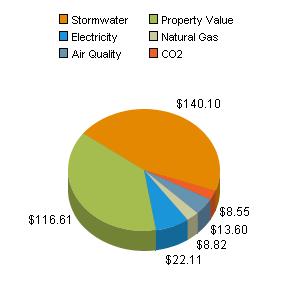
stormwater runoff:
Your 34 inch Trunk Diameter Tree of heaven will intercept 14,151 gallons of stormwater runoff this year.
Urban stormwater runoff (or “non-point source pollution”) washes chemicals (oil, gasoline, salts, etc.) and litter from surfaces such as roadways and parking lots into streams, wetlands, rivers and oceans. The more impervious the surface (e.g., concrete, asphalt, rooftops), the more quickly pollutants are washed into our community waterways. Drinking water, aquatic life and the health of our entire ecosystem can be adversely effected by this process.
Trees act as mini-reservoirs, controlling runoff at the source. Trees reduce runoff by:
- Intercepting and holding rain on leaves, branches and bark
- Increasing infiltration and storage of rainwater through the tree’s root system
- Reducing soil erosion by slowing rainfall before it strikes the soil
For more information visit: The Center for Urban Forest Research
Energy:
Your 34 inch Trunk Diameter Tree of heaven will conserve 291 Kilowatt hours of electricity for cooling and reduce consumption of oil or natural gas by 8 therm(s).
Trees modify climate and conserve building energy use in three principal ways (see figure at left):
- Shading reduces the amount of heat absorbed and stored by buildings.
- Evapotranspiration converts liquid water to water vapor and cools the air by using solar energy that would otherwise result in heating of the air.
- Tree canopies slow down winds thereby reducing the amount of heat lost from a home, especially where conductivity is high (e.g., glass windows).
Strategically placed trees can increase home energy efficiency. In summer, trees shading east and west walls keep buildings cooler. In winter, allowing the sun to strike the southern side of a building can warm interior spaces. If southern walls are shaded by dense evergreen trees there may be a resultant increase in winter heating costs.
For more information visit: The Center for Urban Forest Research
Air Quality:
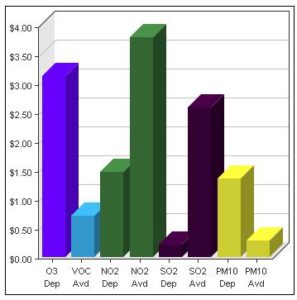
Air pollution is a serious health threat that causes asthma, coughing, headaches, respiratory and heart disease, and cancer. Over 150 million people live in areas where ozone levels violate federal air quality standards; more than 100 million people are impacted when dust and other particulate levels are considered “unhealthy.” We now know that the urban forest can mitigate the health effects of pollution by:
- Absorbing pollutants like ozone, nitrogen dioxide and sulfur dioxide through leaves
- Intercepting particulate matter like dust, ash and smoke
- Releasing oxygen through photosynthesis
- Lowering air temperatures which reduces the production of ozone
- Reducing energy use and subsequent pollutant emissions from power plants
It should be noted that trees themselves emit biogenic volatile organic compounds (BVOCs) which can contribute to ground-level ozone production. This may negate the positive impact the tree has on ozone mitigation for some high emitting species (e.g. Willow Oak or Sweetgum). However, the sum total of the tree’s environmental benefits always trumps this negative.
For more information visit: The Center for Urban Forest Research
CO2:
This year your 34 inch Trunk Diameter Tree of heaven tree will reduce atmospheric carbon by 1,236 pounds.

How significant is this number? Most car owners of an “average” car (mid-sized sedan) drive 12,000 miles generating about 11,000 pounds of CO2 every year. A flight from New York to Los Angeles adds 1,400 pounds of CO2 per passenger. Trees can have an impact by reducing atmospheric carbon in two primary ways (see figure at left):
- They sequester (“lock up”) CO2 in their roots, trunks, stems and leaves while they grow, and in wood products after they are harvested.
- Trees near buildings can reduce heating and air conditioning demands, thereby reducing emissions associated with power production.
Combating climate change will take a worldwide, multifaceted approach, but by planting a tree in a strategic location, driving fewer miles, or replacing business trips with conference calls, it’s easy to see how we can each reduce our individual carbon “footprints.”
For more information visit: The Center for Urban Forest Research
The data for this post were taken from the
National Tree Benefit Calculator website


